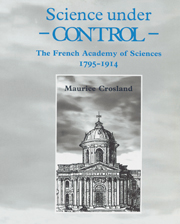Book contents
- Frontmatter
- Contents
- List of tables and figures
- Preface
- List of abbreviations
- INTRODUCTION
- 1 SCIENCE IN FRANCE
- 2 THE STRUCTURE OF THE ACADEMY
- 3 THE FUNCTIONING OF THE ACADEMY: SOME POSSIBLE ROLES
- 4 SCIENCE DIVIDED: THE SECTIONS
- 5 THE ACADEMICIANS
- 6 ELECTIONS: ‘GREEN FEVER’
- 7 REGISTRATION, JUDGEMENT AND REWARD
- 8 THE PRINTED WORD
- 9 AN ACADEMY UNDER GOVERNMENT CONTROL
- 10 ‘OUTSIDERS’: THE SCIENTIFIC FRINGE AND THE PUBLIC
- 11 THE INTERNATIONAL DIMENSION
- 12 THE CONTROL OF THE ACADEMY AND OF SCIENCE
- Name index
- Subject index
2 - THE STRUCTURE OF THE ACADEMY
Published online by Cambridge University Press: 09 October 2009
- Frontmatter
- Contents
- List of tables and figures
- Preface
- List of abbreviations
- INTRODUCTION
- 1 SCIENCE IN FRANCE
- 2 THE STRUCTURE OF THE ACADEMY
- 3 THE FUNCTIONING OF THE ACADEMY: SOME POSSIBLE ROLES
- 4 SCIENCE DIVIDED: THE SECTIONS
- 5 THE ACADEMICIANS
- 6 ELECTIONS: ‘GREEN FEVER’
- 7 REGISTRATION, JUDGEMENT AND REWARD
- 8 THE PRINTED WORD
- 9 AN ACADEMY UNDER GOVERNMENT CONTROL
- 10 ‘OUTSIDERS’: THE SCIENTIFIC FRINGE AND THE PUBLIC
- 11 THE INTERNATIONAL DIMENSION
- 12 THE CONTROL OF THE ACADEMY AND OF SCIENCE
- Name index
- Subject index
Summary
Our working meetings follow each other according to a common pattern and with the regularity of astronomical events. No festival, no great event prevents the Academy from meeting once a week to receive and register research work and to discuss impersonal truths.
(G. Lippman, Public meeting of 16 December 1912, C.R., 155 (1912), 1277.)A person, who devotes his life to the study of the sciences or the arts, must surely know how to control his desires and regulate his needs.
(Report by Villers on honoraria for members of the Institute, 21 May 1796, reproduced in L. Aucoc, L'Institut de France, 1889, p. 36.)Turning up every Monday at about 3 o'clock at the Institute, signing the attendance register on arrival, accepting the minutes of the previous meeting, helping at every other meeting (each fortnight) in analysing the correspondence without taking in a word of it, paying no attention to most purely scientific communications but being all ears on matter of personality, cutting short the public part of the meeting, which is mainly concerned with the former, in order to be able to prolong the secret session, where the latter can be discussed at leisure, nominating for the examination of memoirs sent by scientists from outside, commissions which will not in fact examine anything, finally between 5 and 6 o'clock going to dinner – this is what [the secretary of the Academy] calls working with the greatest activity.
(Victor Meunier, Scènes et types du monde savant, 1889, pp. 182–3.)- Type
- Chapter
- Information
- Science under ControlThe French Academy of Sciences 1795–1914, pp. 50 - 90Publisher: Cambridge University PressPrint publication year: 1992



